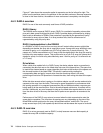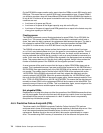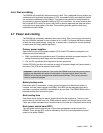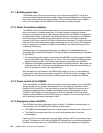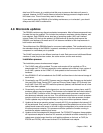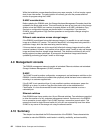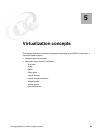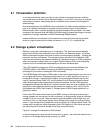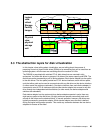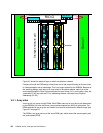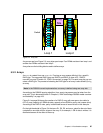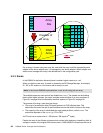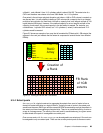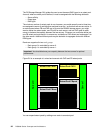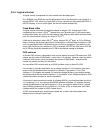84 DS8000 Series: Concepts and Architecture
5.1 Virtualization definition
In our fast-paced world, where you have to react quickly to changing business conditions,
your infrastructure must allow for on demand changes.
Virtualization is key to an on demand
infrastructure. However, when talking about virtualization many vendors are talking about
different things.
One important feature of the DS8000 is the virtualization of a whole storage subsystem. If you
have to run different workloads, for example a service provider might run workloads for
different banks, then it might be desirable to completely separate the workloads. This could
be done on the processor side with IBM’s LPAR technology; the same technology is now also
available for a storage subsystem, the IBM TotalStorage DS8000 system.
Another definition of virtualization is the abstraction process going from the physical disk
drives to a logical volume that the hosts and servers
see as if it were a physical disk.
5.2 Storage system virtualization
IBM has a long history and experience in virtualization. This goes back several decades,
when virtual memory was introduced in the mid 1960s in the operating system. At that time
IBM also developed a system that could virtualize a whole processor complex – including the
processor, memory, and devices. This operating system was called Virtual Machine (VM).
Later on this functionality also became available as a hardware function on S/390 processors.
When the processor complex was run in Logical Partition Mode (LPAR), several operating
systems could run isolated and independently on the same hardware base.
This LPAR capability heritage from S/390 and zSeries has now become available on the
POWER5 pSeries. The DS8000 is based on POWER5 technology, so we can take
advantage of its functions, including the LPAR functionality.
The DS8300 Model 9A2 supports LPAR mode. In the current implementation, you can run up
to two logical partitions on a physical storage system unit. In each partition you can run a
storage facility image. A storage facility image is a virtual storage subsystem with its own
copy of Licensed Internal Code (LIC), which consists of the AIX kernel and the functional
code. Both storage facility images share the physical hardware and the LPAR hypervisor
manages this sharing of the hardware. Currently, however, there are some limitations on the
granularity of how the physical resources like processors, memory, cache, and I/O can be
split between the LPARs. See Chapter 3, “Storage system LPARs (Logical partitions)” on
page 43 for details.
Like in non-LPAR mode, where there are two SMPs running an AIX kernel and forming a
storage complex with two servers, server0 and server1, a storage facility image is a storage
complex of its own, but since it does not own the physical hardware (the storage unit), you
can think of it as a virtual storage system. Each storage facility image has a server 0 and a
server 1. Each storage facility image can run its own version of Licensed Internal Code. The
storage facility images are totally separated by the LPAR hypervisor. Disk drives and arrays
are owned by one or the other storage facility, they cannot be shared.
Figure 5-1 on page 85 illustrates the LPAR concept.
In the following section, when we talk about server 0 or server 1 we could also mean server 0
or server 1 of a storage facility image running in an LPAR.



